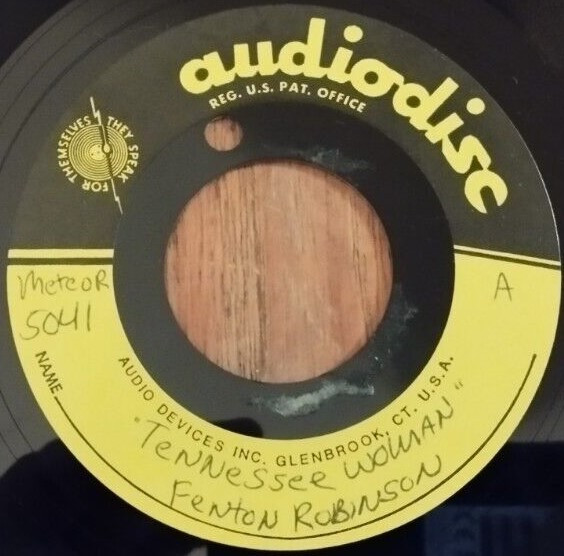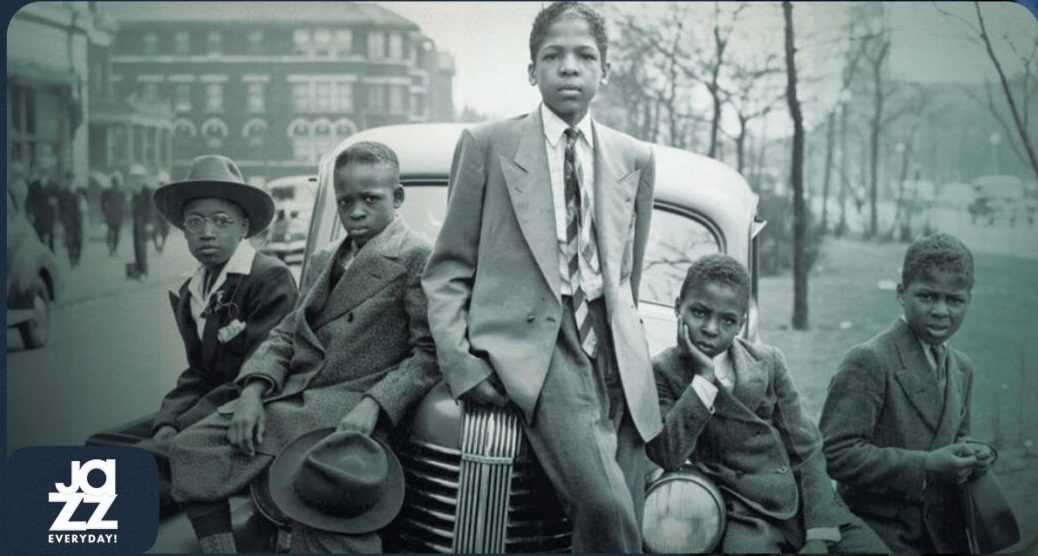
“In a world of barroom entertainers Fenton Robinson was a serious musician who is best appreciated with greater concentration than the audience usually gave him”
– Bruce Iglauer, Alligator Records
A frequent reader of the Blues For A Big Town music blog commented that a majority of the articles are about under appreciated musicians.
While I don’t entirely agree with that assessment, I will say to that reader and to anyone else of the same mind, that with this write-up on Fenton Robinson I guess I might be doing it again.
Some of the most ardent of Blues fans may not be familiar with Chicago Bluesman Fenton Robinson.
Some of those same fans, however, may be acquainted with Robinson’s signature song “Somebody Loan Me A Dime”. But in saying that, Robinson might draw the short end of the stick because the same fans could realistically associate the song with Blues / Soul / Rock & Roll artist Boz Scaggs’ exhilarating version featuring a driving finale powered by Duane Allman on guitar.
(An aside: Boz originally took credit for the song; a move that initiated a lawsuit. Without getting into a long and involved, suffice to say that Robinson recorded the song on the Palos imprint, a small Chicago label in 1967, a full two years before Scaggs’ Atlantic Records cover hit the streets. That fact, supported by the court’s ruling, ensured that Robinson, and now his estate after Robinson’s passing, continues to receive rightful credit and royalties).
As one might suspect there’s more to the Fenton Robinson story than a singular signature song.
In fact, Robinson, a true connoisseur’s choice, recorded a number of influential songs typified by his incomparable, highly innovative, and Jazz tinged, fluid guitar style.
Dialing it back, Fenton Lee Robinson was born on a cotton plantation in LeFlore County in the Mississippi delta on September 23, 1935. (There are a number of “name” Blues artists that came from around the same area including B.B. King, Albert King, Howlin’ Wolf, and Muddy Waters).
After first being exposed to Blues through local jukeboxes young Fenton was quickly taken by the rural stylings of Lightnin’ Hopkins and the more urbane T-Bone Walker. Both of these guitarists, (especially Walker), would continue to be prime influences throughout Robinson’s career going forward.
Fenton’s own path to being a brilliant guitar player started humbly.
He began on a home made one string guitar before graduating to a real guitar – a $13 Stella. Always a serious student of the instrument, Fenton bettered himself by taking lessons. At 16 years of age, young Fenton could account for himself as having reasonable command of the guitar. Thus, Fenton had cleared the first major hurdle in the course of following his dream of playing the Blues.
Robinson, who would move to various locales in the course of his life and profession, made his first sojourn to Memphis in 1953 at the age of 18.
Upon arrival, Robinson worked at a tomato packing plant to tide him over while he pursued his dream. But it wasn’t long before Fenton started playing music full time, including playing a number of local amateur shows.
Although Fenton, as stated, started playing guitar two years earlier, it was in Memphis that he became a legitimate guitar player under the tutelage of local guitar player Charles McGowan. Forming a bond, billing themselves as “The McGowan Brothers”, the duo started playing the streets of Memphis and soon graduated to playing the local clubs.
After a couple of years in Memphis, “The McGowan Brothers” decided to broaden their respective horizons by venturing out to other destinations.
Both with McGowan and on his own, the next eight years would find Fenton ping ponging between Little Rock Arkansas, East St. Louis, Memphis, and California. The various moves were predicated on finding work sufficient to pay the bills.
In Little Rock he met multi-instrumentalist Larry Davis, a sometime band member holding down either the drums or bass chair, as required.

Three years later, Davis would play drums as a member of The Dukes, a band assembled to back Robinson on the recording of “Tennessee Woman”. “Tennessee Woman” was Fenton’s first notable single release and along with McGowan on guitar, and Davis on drums the band was rounded out by an unknown bass and keyboard player. Cut in Memphis for the Bihari Bros’ Meteor label, (possibly at Sam Phillips Sun Studios, that the brothers would use when they were in town recording).

The recording was part of a short stay in Memphis where a lack of regular bookings prompted a move back to East St. Louis among other destinations including a return to Little Rock.
Circling back to Little Rock would prove to be a turning point of sorts because it was a performance at Little Rock’s Flamingo Club that led to Robinson’s first recording contract. It happens that Bobby Bland caught Fenton and Larry Davis; and was impressed enough to bring them to the attention of Don Robey at Duke-Peacock Records.
Duke-Peacock at the time was the largest Black owned label in the country; and had a roster that included Bland as well as the likes of Little Richard, Otis Rush, Gatemouth Brown, Memphis Slim, Roscoe Gordon, and Big Mama Thornton.
Robey decided to sign both Robinson and Davis.
In his 2 year stint, (1958-1959), with the label Robinson played on Davis’ classic “Texas Flood” – which became a Stevie Ray Vaughan signature tune – in addition to cutting 4 solo sides. Notable was Fenton’s first ever recording of a Peppermint Harris number “As The Years Go Passing By”. (While Fenton attributed the song to Harris like most recordings on Duke-Peacock, the song credit reads Deadric Malone, Robey’s pseudonym).
In 1962, at the age of 27, Robinson moved to Chicago and started to establish himself as a Chicago Bluesman.
He started a 5 year residency at Theresa’s Lounge working both as a sideman as well as fronting his own band. (Musicians he regularly backed included Sonny Boy Williamson II, Junior Wells, Charlie Musselwhite, and Otis Rush among others). Along the way he also cut some sides for small local labels in addition to writing songs for other artists like Lowell Fulson.
Moving on from Theresa’s, he held down a steady gig at the Peppermint Lounge. It was at this time that Fenton’s style, as we know it today, started to evolve.
Displaying the influences of T-Bone Walker, Pee Wee Crayton, and B.B. King. Robinson termed his approach to the Blues as “Texas Style” (that was most closely associated with T-Bone Walker’s heady mix of Swing, Jazz, and Blues). Namely, Fenton’s “Texas Swing” featured a clean tone, a mellower sound, and improvisational changes.
This method set him apart from his contemporaries who favoured a heavier attack. This hard edged take is built on an emphasis on single notes, string bends, and heavily punctuated fills. In short, Fenton Robinson presented a smoother side of Chicago’s Blues scene. And, to top it all off, Robinson offered complimentary vocals – relaxed, understated, and convincing.
Despite his many hours of working a crowd and maintaining a steady presence he was, and continues to be, an unsung hero of Chicago Blues. Given his profile, it’s somewhat surprising that he was invited to participate in the Battle For King Of The Blues show at The Regal Theatre – alongside B.B. King, Albert King, and Bobby Bland – in 1968.
If Robinson got any traction at all in the aftermath of the Regal show, his career was briefly derailed in 1969 by a prison term served for vehicular involuntary manslaughter. Fortunately, Robinson earned an early release after 9 months on the strength of efforts spearheaded by Alligator label boss Bruce Iglauer, and aided by Blues fans’ letter writing campaign.
In 1970, at 35 years of age Fenton recorded his first album.
Cut for John Richbourg’s** Nashville based Studio Stage 7 label, Mello Fellow, is actually a collection of sides recorded in Nashville and Memphis. The material pushed Robinson in a more Rock oriented direction featuring his vocals but very little of his guitar. Of the 12 entries 6 were recorded in Nashville, that feature Fenton’s vocals only. The remaining 6, cut in Memphis, showcase both Fenton’s vocals and guitar.
** Some may be familiar with Richbourg as John R, a renowned deejay on Nashville’s WLAC promoting Blues and R&B in addition to producing records
In retrospect both Richbourg and Robinson acknowledged that the restrictive Rock oriented approach didn’t serve Robinson’s talents well given Fenton’s freer more Jazz directed feel to matters at hand.
Fenton remained in Chicago in the 70’s and signed with Alligator Records. In many critics’ and fans’ eyes the 3 albums that Robinson recorded on Alligator: Somebody Loan Me A Dime (1974), I Hear Some Blues Downstairs (1977), and Night Flight (1984) stand individually and collectively as his best recordings. Of note “Dime” is universally considered Fenton Robinson’s high water mark.
It should be noted that the 3 aforementioned releases didn’t earn him significant commercial success. but it’s also noteworthy to cite that “Downstairs” was both a Grammy nominated and Blues Hall Of Fame inducted recording. The album features a stellar remake of “As The Years Go Passing By”.
In later years Fenton recorded for various European labels. In live performances Fenton performed regularly in Chicago, toured various Blues circuits both Nationally and Internationally and appeared at a number of high profile festivals.
After a brief move back to Little Rock, Fenton relocated to Springfield Illinois where he taught Blues history and guitar techniques in the local school system as well as continuing to perform.
Robinson started to experience health problems in the 90’s. He died on November 25, 1997 of brain cancer at the age of 62.
While not a household name to the mass Blues crowd, Fenton Robinson was and continues to be a favourite of critics, peers, and discerning fans. Practicing a scholarly brand of blues featuring complex, well structured lines.in a spur of the moment unhurried style.
Internationally known, Fenton Robinson’s Japanese audiences referred to him as “The Mellow Blues Genius”.
Fitting!
FENTON ROBINSON PLAYLIST
Rico Ferrara, Originally Posted on June 8, 2025 “Blues For A Big Town” blog.
